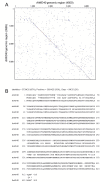Targeted identification of genomic regions using TAGdb
- PMID: 20727174
- PMCID: PMC2939534
- DOI: 10.1186/1746-4811-6-19
Targeted identification of genomic regions using TAGdb
Abstract
Background: The introduction of second generation sequencing technology has enabled the cost effective sequencing of genomes and the identification of large numbers of genes and gene promoters. However, the assembly of DNA sequences to create a representation of the complete genome sequence remains costly, especially for the larger and more complex plant genomes.
Results: We have developed an online database, TAGdb, that enables researchers to identify paired read sequences that share identity with a submitted query sequence. These tags can be used to design oligonucleotide primers for the PCR amplification of the region in the target genome.
Conclusions: The ability to produce large numbers of paired read genome tags using second generation sequencing provides a cost effective method for the identification of genes and promoters in large, complex or orphan species without the need for whole genome assembly.
Figures




References
-
- Imelfort M, Batley J, Grimmond S, Edwards D. In: Plant Genomics. Somers D, Langridge P, editor. Gustafson J: Humana Press (USA); 2009. Genome sequencing approaches and successes; pp. 345–358. full_text. - PubMed
LinkOut - more resources
Full Text Sources
Other Literature Sources

